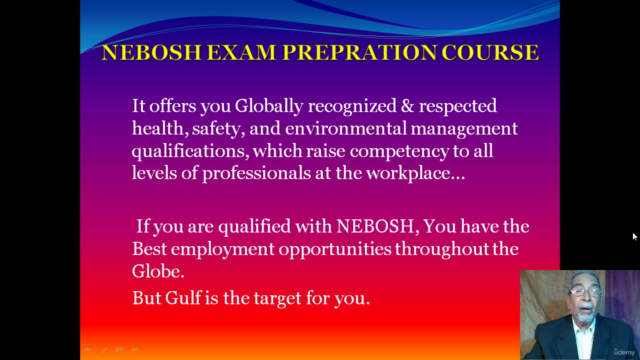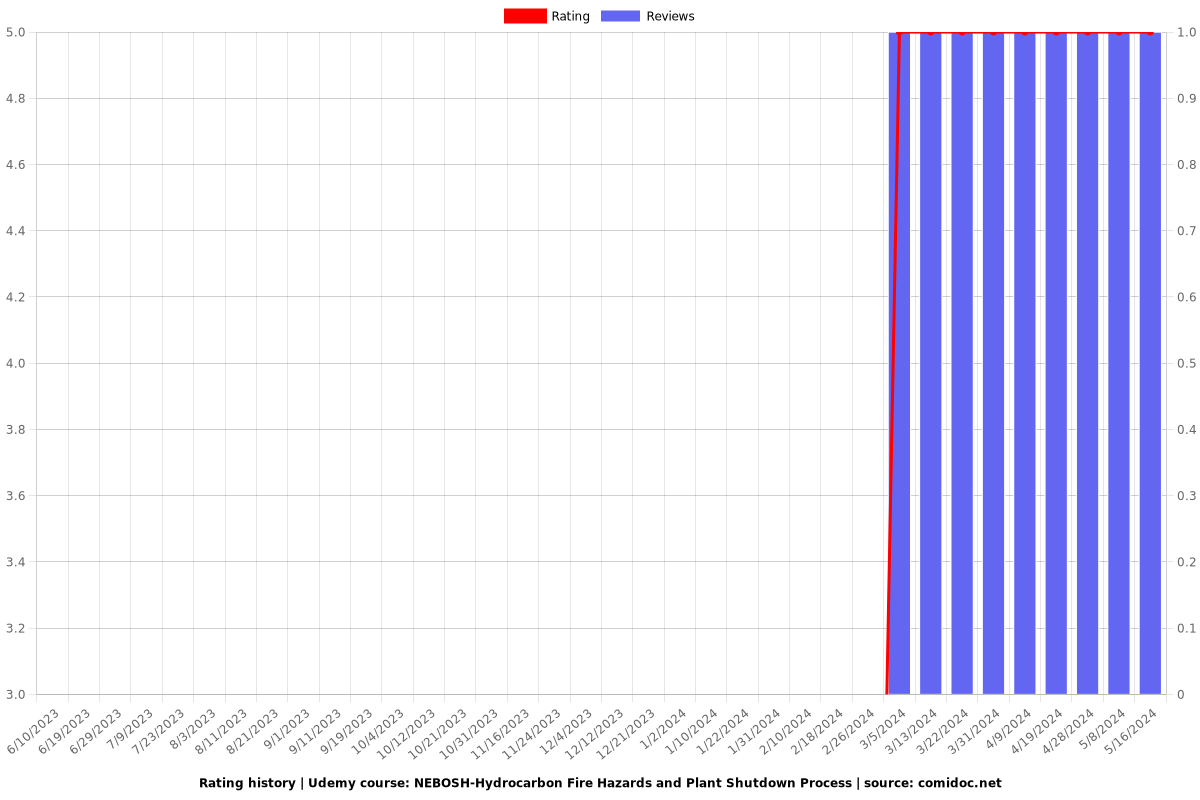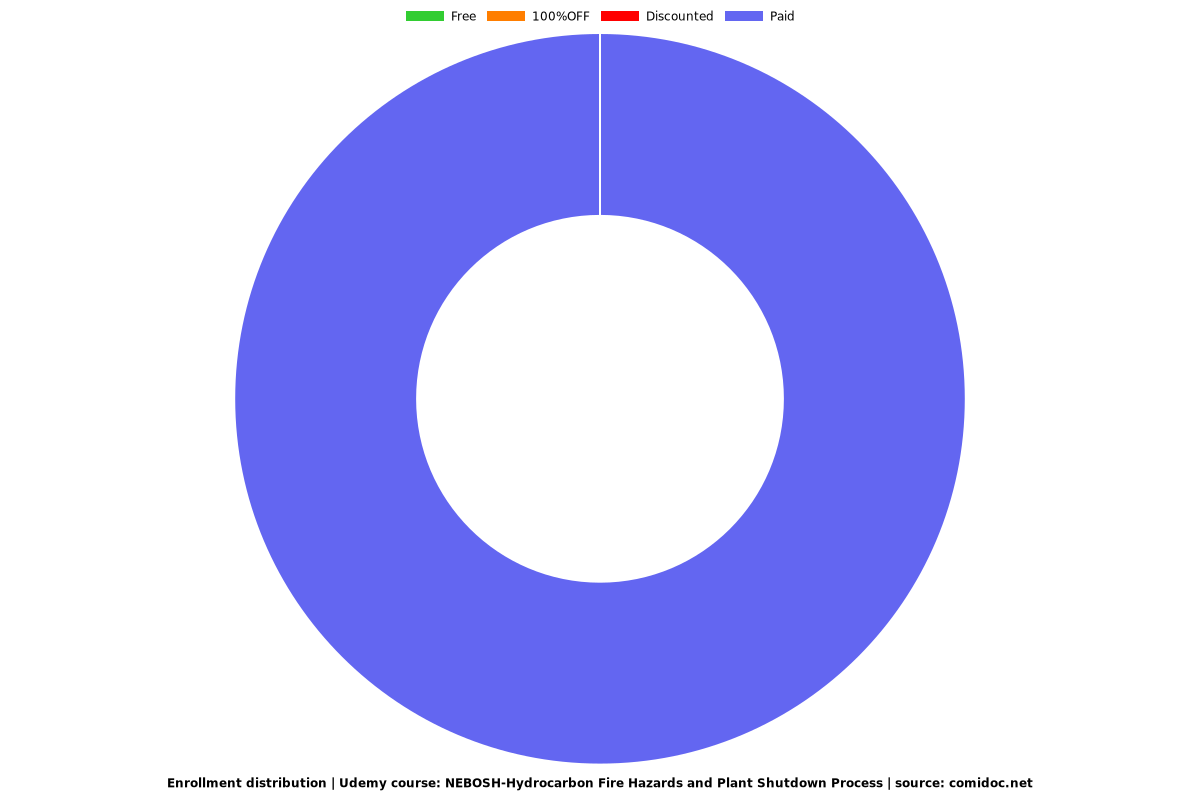NEBOSH-Hydrocarbon Fire Hazards and Plant Shutdown Process
Process Start up and Shutdown Fire Hazards and Controls,

What you will learn
Learn about detection of fire. Smoke detectors, Ionization devises, Radiation detectors, heat detectors, thermal lag, fire fighting equipment.
Learn about fire extinguishers marking, types of fire extinguishers, use of water fire extinguishers, foam fire extinguishers, dry powder fire extinguishers,
Learn about the use of CO2 extinguishers, wet chemical fire extinguishers, Vapourizing liquid extinguishers. Equipment sighting, Fire extinguishers maintenance
Learn about extinguishing media - Removing the Oxygen, heat. Application of water, foam, dry chemical powder, CO2, and Vapouring liquids as per different class
Learn about Fire fighting Training, Types of fire fighting equipment used like fire blankets, hose reels etc.
Learn about Automatic sprinklers, Drenchers, Hydrants and foam inlets etc.
Learn about Extinguishing media. Removing the fuel, Oxygen and heat.
Learn about Class of fire and extinguishing media, water, foam, dry chemical powder, CO2, Vapourizing liquids
Learn about Means of Escape. Escape travel distance vs time. escape from stairs, passways, doorways, what is one unit width of escape?
Learn about Glass doors and smoke control doors. Fire door quality. emergency lighting.
Learn sbout set up of emergency lighting, exit doors and directional signs, emergency exit and escape root signs
Learn about Assembly points. Emergency evacuation procedures. Fire Marshal and warden and their duties.
Learn about Fire drills, roll calls and missing personnel. safety provision for the disables.
Lear about the Plant Start up and Shut down Hazards as follows:
Learn Start up and shutdown practice. safe startup and shutdown operating procedurees and instructions. Mixing of air with hydrocarbons as explosive hazard
Learn about formation of hydrates. Corrosive and Toxic fluids and gasses. Safety Critical elements. Startup and thermal shock. Causes of Catestrophic failures.
Learn about Thermal shocks. Control of thermal shocks. Procedure of startup operations.
Learn about shutdown operations. Valves interlocking system and valve keys. Colours of keys.
Learn about Presence and removal of Water and Hydrates. How to control water hydrates?
Learn about how to Remove water? Removal of water by Gravity Separation Method.
Learn about Oil Separation by Centrifugal System. Water Removal Process. Vacuum Dehydration. Air stripping. Natural evaporation.
Learn about Summary of methods of hydrate removal. Testing and commissioning hazards. HAZOP study of risk and Assessment. Commissioning process inspections.
Learn about Commissioning process in detail. Pipe work and system integrity. Commissioning of Instrumentation. Commissioning of Alarrms.
Learn about Commissioning of Pipelines and vessels. Commissioning of all the Vessels, Ancillary Equipment, and Instruments. Commissioning and start-up.
Learn about Shutdown procedure. Commissioning Procedures and Trials. Commissioning and Handover Procedure.
Why take this course?
Part- 2A - Hydrocarbon Process Fire Hazards and Controls
How to detect fire? Different types of Smoke detectors, Ionization devices, Radiation detectors, heat detectors, thermal lag, and fire fighting equipment.
Fire extinguishers marking and identification, different types of fire extinguishers.
Use of water fire extinguishers, foam fire extinguishers, and dry powder fire extinguishers.
Use of CO2 extinguishers, wet chemical fire extinguishers, and Vaporizing liquid extinguishers.
Equipment sighting, Fire extinguishers maintenance.
Extinguishing media - Removing the Oxygen, and heat.
Application of water, foam, dry chemical powder, CO2, and Vaporizing liquids as per different classes.
Part 2B
Fire fighting Training.
Types of fire fighting equipment:
Fire blankets, Hose reels. automatic sprinklers, Drenches, Hydrants, and foam inlets. Learn about Extinguishing media. Removing the fuel, Oxygen, and heat.
Different classes of fire and extinguishing media, water, foam, dry chemical powder, CO2, and Vaporizing liquids.
What is Means of Escape? Safe escape travel distance vs time.
Escape from stairs, passways, doorways,
What is one unit width of escape?
Fire resistance Glass doors and smoke control doors. Fire door quality. emergency lighting.
Part-2C
Set up of emergency lighting. Exit doors and directional signs. emergency exit and escape root signs.
Assembly points. Emergency evacuation procedures.
Who is the Fire Marshal and Warden and their duties?
Fire drills, roll calls, and how to find missing personnel.
Safety provision for disabled persons.
Part-2D Plant Start-up and Shut down Hazards
Plant start-up and shutdown practice—safe startup and shutdown operating procedures and instructions.
Danger of air inclusion with hydrocarbons and control of explosive hazards.
How the formation of hydrates will occur?
Corrosive, Toxic fluids and gasses.
What are the Safety Critical elements?
Startup and thermal shock precautions and control.
Different causes of Catastrophic failures.
How will the thermal shocks occur? Control of thermal shocks.
The procedure of startup operations.
Special Valve operation and interlocking system.
Safe application of valve keys. Design and Color system of valve keys for safe operations.
Procedure of shutdown operations.
Part-2E Plant Start-up and Shut down Hazards
The presence and removal of Water and Hydrates from hydrocarbons.
How to Control Water Hydrate? How to Remove Water?
Removal of water by Gravity Separation Method.
Procedure of oil Separation by Centrifugal System.
Procedure of water removal Process. Procedure of Vacuum Dehydration, air stripping, and Natural evaporation.
Procedure and description of different methods of hydrate removal.
Testing and commissioning hazards. HAZOP study of risk and Assessment.
Commissioning process and inspections.
Procedure and description of the Commissioning process in detail.
Confirmation of Pipework and system integrity.
Procedure of commissioning of Instrumentation and Alarms.
Detailed procedure of commissioning of Pipelines and vessels and all the other Vessels.
Commissioning of Ancillary Equipment, and Instruments.
Finally commissioning and start-up of the Plant.
Detail procedure of Shutdown process.
Plant Commissioning Procedures and Trials.
Commissioning and Handover Procedure of the Plant to the Department.
Screenshots




Charts
Price

Rating

Enrollment distribution
